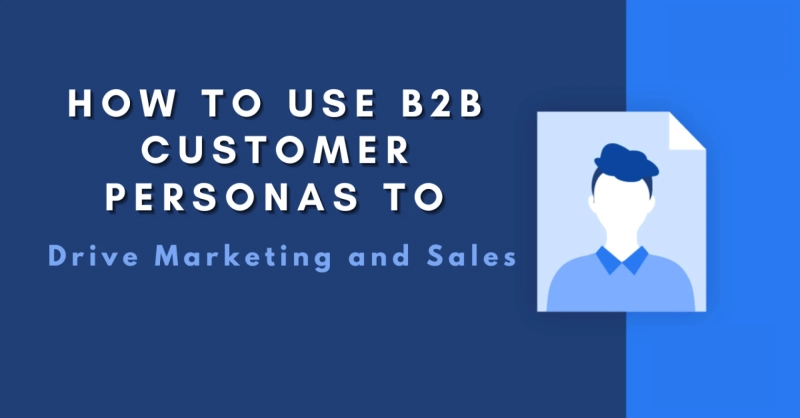Knowing your target market is crucial in the ever-changing world of business-to-business marketing. Creating and applying B2B customer personas is one of the best methods for obtaining this knowledge. These in-depth depictions of your potential clients may significantly improve your sales and marketing campaigns. The significance of B2B client personas, how to create them, and how to use them to boost marketing and sales will all be covered in this article.
What is a B2B Customer Persona?
A B2B customer persona is a semi-fictional depiction of your ideal client derived from precise facts on your current clients and market research. In contrast to B2C personas, which frequently concentrate on individual customers, B2B personas consider the features of businesses, such as their industry, size, difficulties, and decision-making processes. Companies may better satisfy the demands of their target audience by customising their marketing and sales tactics with the aid of these personas.
The Importance of B2B Customer Personas
In every business, knowing your clients is essential. Customer personas give clarity and direction to B2B firms, where the sales process is usually more complicated and involves several stakeholders. Here\'s why they are essential:
- Enhanced Targeting: B2B customer personas help you more precisely categorise your audience and target the appropriate firms with your marketing efforts.
- Improved Messaging: By understanding your ideal consumers\' objectives, motivations, and pain areas, you can create messages that connect with them.
- Better Alignment: Customer personas aid in team alignment. They help marketing and sales teams align by giving them a shared understanding.
- Resource Allocation: When you have defined personas, you can focus on techniques most likely to produce results and use your marketing money and resources more effectively.
Building B2B Customer Personas
Investigation, data analysis, and insights from several sources are necessary to create accurate and valuable B2B customer profiles. Here\'s a step-by-step guide to building B2B customer personas:
- Conduct Market Research
Begin by compiling information from various sources, including market surveys, competition analyses, and industry studies. This will assist you in comprehending the larger picture and identifying traits that your target market shares.
- Analyse Your Existing Customer Base
Look at your present clientele to spot trends and patterns. Examine the company\'s size, sales, location, industry, and difficulties. This information is crucial for comprehending top clients\' decisions to use your goods or services.
- Gather Qualitative Insights
Conduct surveys and interviews to learn more about your consumers\' wants, preferences, and pain spots. These discussions can provide important information that quantitative data alone cannot.
- Identify Key Characteristics
Based on your research and analysis, identify the key characteristics that define your ideal customers. These might include:
- Demographics: Industry, company size, location
- Firmographics: Revenue, number of employees, growth stage
- Behavioural Insights: Buying behaviours, decision-making processes, preferred communication channels
- Pain Points: Common challenges and obstacles your customers face
- Goals and Objectives: What your customers are aiming to achieve with your products or services
Leveraging B2B Customer Personas for Marketing and Sales
Using your B2B client personas to inform your marketing and sales strategy is the next step after creating them. Here\'s how:
- Personalise Your Marketing Campaigns
Customise your marketing strategies and messaging by using your personalities. Let\'s say that one of your identities is a mid-sized tech business that wants to grow. If so, provide material highlighting how your solution can assist them in achieving scalability while addressing their growth concerns.
- Optimise Content Marketing
Create content that precisely addresses the requirements and passions of your characters. Consider your personas when creating blog entries, whitepapers, case studies, and webinars. This guarantees that your target audience will find your material helpful and relevant.
- Enhance Email Marketing
Segment your email lists based on profiles to create individualized email campaigns that speak to each persona\'s goals and pain areas. Personalized emails are more likely to be opened and interacted with, increasing conversion rates.
- Improve Lead Nurturing
Using personas, you can create customized lead nurturing efforts. By knowing each persona\'s journey, you can design personalized processes that lead prospects through the sales funnel and cater to their unique demands at each stage.
- Align Sales Strategies
Give your sales staff thorough prospect profiles to better understand the people they are interacting with. Sales representatives can customize their interactions and proposals to better meet each character\'s wants and concerns.
- Refine Product Development
Personas also help guide product development by emphasizing the characteristics and solutions most essential to your target market. This guarantees that your product development activities meet the market\'s demands.
Measuring the Impact of B2B Customer Personas
You must measure their effect to ensure that your B2B customer personas produce outcomes. Monitor essential data, including customer satisfaction, lead generation, conversion rates, and expenditures associated with acquiring new customers. Use this information to enhance your marketing and sales tactics and personalities.
Conclusion
B2B client personas are an effective tool for boosting sales and marketing efforts. Creating precise and in-depth personas can help you better target, communicate, and synchronise your teams. This results in improved customer relations, successful marketing efforts, and sales. It will be worthwhile to put in the time and effort to create and use B2B customer personas, as they will provide you with a better knowledge of your clients and make it easier to fulfil their wants.


